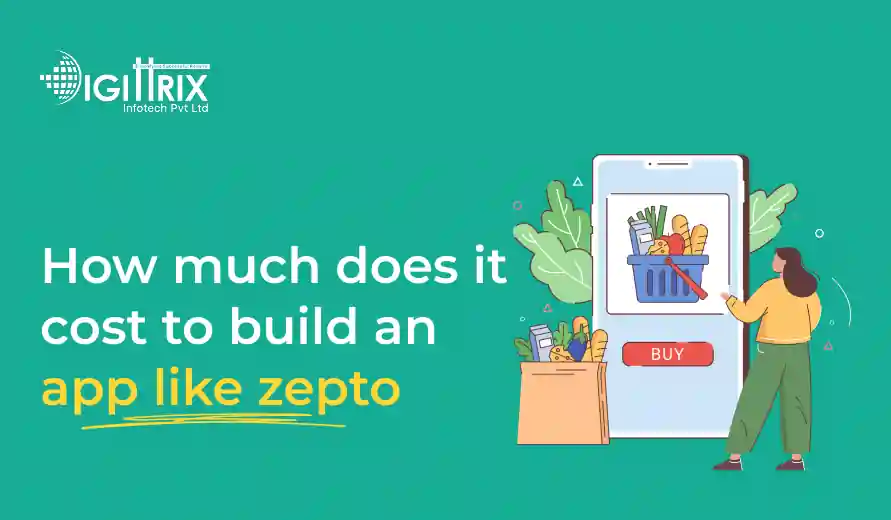Instant grocery apps like Zepto enable delivery within 10 minutes, increasing customer convenience, order frequency, and market growth for grocery businesses in urban areas.
Highlights
An enthusiastic developer and skilled business management expert with over a decade of experience in the field

In today’s fast-paced world, grocery shopping has experienced a major transformation. Waiting hours or even a day for groceries is now considered outdated. Customers now expect their essentials to be delivered in minutes. Zepto, an Indian startup, has popularized the idea of instant grocery delivery, promising products at your door in just 10 minutes.
This growing trend has created a demand for entrepreneurs aiming to develop an Instant Grocery App or a 10-minute grocery delivery app. But one of the first questions that comes up is: how much does it cost to build an app like Zepto?
The cost depends on several factors, such as features, design, technology stack, team location, and development time. In this article, we’ll examine these factors, outline the essential features, and provide a detailed cost estimate for developing a Zepto clone app.
Explore the best grocery apps with our guide: Digittrix’s detailed guide on the top 10 grocery apps to make your shopping easier!
Consumers today prioritize speed, convenience, and reliability. Traditional grocery stores or even online platforms often take hours or a day to deliver, which isn't suitable for last-minute needs. A grocery mobile app development solution like Zepto addresses this issue by providing instant grocery delivery, allowing customers to place orders and receive them almost immediately.
The benefits of creating such an app include:
By emphasizing speed, product variety, and user-friendliness, an Instant Delivery App can rapidly become a profitable business.
When developing a Zepto clone app, features play a crucial role in determining the cost. The more advanced the feature, the higher the development expense. Let’s break down the key features and their descriptions:
Adding features like loyalty programs, subscription options, voice search, or AI-based recommendations can further enhance the app’s appeal but will also increase costs.
Several elements influence the total cost of developing a grocery app.
Here’s a detailed estimate for developing a 10-minute grocery delivery app, listed in INR and USD:
This is perfect for startups or small businesses focusing on a single area.
Ideal for businesses expanding to multiple neighborhoods.
Ideal for large-scale operations spanning multiple cities with high delivery demand.
Building an app involves more than just development:
A Zepto clone app development project typically follows this schedule:
Total: 3 to 9 months, depending on complexity.
Revenue can come from several streams:
A solid business model guarantees quicker investment recovery and sustained profitability.
The instant grocery delivery app market is rapidly expanding in urban areas. With rising smartphone use and shifting shopping habits, there is significant opportunity for businesses that start investing now.
By adding features like AI-based recommendations, real-time inventory tracking, and subscription models, businesses can build customer loyalty and stay competitive.
Professional developers in instant grocery delivery app development offer multiple advantages:
Working with experienced developers ensures your grocery mobile app development project meets customer expectations and stays on track and competitive.
Planning to develop an instant grocery app? Check out Digittrix’s comprehensive guide on building an app like Blinkit in 2025 for insights on features, cost, and revenue models!
Building an app like Zepto is an investment, but it can be profitable in the long run. With costs ranging from:
Businesses can choose a solution that fits their budget and growth plans.
By carefully planning features, selecting the right development team, and managing maintenance and marketing, you can create a grocery mobile app that attracts customers, builds loyalty, and increases revenue.
Building an instant grocery delivery app like Zepto can help you stay competitive in the modern grocery market and reach a growing urban audience seeking convenience.
Developing a Zepto clone app can help businesses tap into India’s rapidly growing quick commerce market, providing customers with groceries delivered in just minutes. A successful app should feature a simple and intuitive interface for easy browsing, multiple secure payment options, and an intelligent delivery system to ensure fast order fulfillment.
At Digittrix, we bring over 14 years of experience in grocery mobile app development. We help businesses build instant grocery delivery apps that are fast, scalable, and user-friendly for both customers and delivery teams. Our skills include developing Zepto clone apps and improving the 10-minute grocery delivery experience.
If you’re ready to launch your own Instant Grocery App and enter the expanding instant delivery market, contact us today at +91 8727000867 or email us at digittrix@gmail.com. Let’s work together to turn your idea into a fully functional grocery app ready for business.

Do you need help in Grocery App Development ?




Join over 1500+ businesses we've already helped!
Costs range from 8,00,000 INR / 10,000 USD for a basic app to 35,00,000 INR / 45,000 USD for an advanced, feature-rich version.
Key features include user registration, product catalog, search and filters, cart and checkout, order tracking, delivery agent app, admin panel, and push notifications.
A basic app takes 3–4 months, a mid-level app 5–6 months, and an advanced app 7–9 months, depending on features and complexity.

©2025Digittrix Infotech Private Limited , All rights reserved.